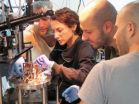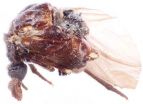(Press-News.org) Philadelphia, PA, July 14, 2014 – The inability to ignore irrelevant stimuli underlies the impaired working memory and cognition often experienced by individuals diagnosed with schizophrenia, reports a new study in the current issue of Biological Psychiatry.
Our brains are usually good at focusing on the information that we are trying to learn and filtering out the "noise" or thoughts that aren't relevant. However, memory impairment in schizophrenia may be related in part to a problem with this filtering process, which Dr. Teal Eich at Columbia University and her colleagues studied.
"Our assumption was that understanding the impairments in the component processes of working memory – the ability to hold and manipulate information in the mind – among patients with schizophrenia could be fundamental to understanding not only cognitive function in the disorder, which is widespread and has debilitating consequences, but also the disorder itself," Eich explained.
The researchers recruited patients with schizophrenia and a control group of healthy volunteers to complete an item recognition task in the laboratory while undergoing a functional magnetic resonance imaging scan. In particular, they focused on analyzing potential activation differences in the ventro-lateral prefrontal cortex (VLPFC), a region of the brain implicated in working memory.
The design of the task allowed for the assessment of the various components of working memory: 1) maintaining the memory itself, 2) inhibiting or ignoring irrelevant information, and 3) during memory retrieval, controlling the interference of irrelevant information.
While simply maintaining the memory, both groups showed a similar degree of activation in the VLPFC. During the inhibition phase, VLPFC activity is expected to decrease, which was indeed observed in the healthy group, but not in the patients. Finally, during interference control, patients performed worse and showed increased VLPFC activation compared to the healthy volunteers. Overall, the patients showed altered VLPFC functioning and significant impairments in their ability to control working memory.
"Our findings show that these patients have a specific deficit in inhibiting information in working memory, leading to impaired distinctions between relevant and irrelevant thoughts," said Eich. "This result may provide valuable insights into the potential brain mechanisms underlying the reasons why these affected individuals are unable to control or put out of mind certain thoughts or ideas."
This study adds to a growing literature suggesting that cognitive functions require both the activation of one set of regions and the inhibition of others. The failure to suppress activation may be just as disruptive to cortical functions as deficits in cortical activation.
Many years ago, the pioneering scientist Patricia Goldman-Rakic and her colleagues showed that the inhibition of regional prefrontal cortical activity was dependent upon the integrity of the GABA (gamma-aminobutyric acid) system in the brain, a chemical system with abnormalities associated with schizophrenia.
"We need to determine whether the cortical inhibitory deficits described in this study can be attributed to particular brain chemical signaling abnormalities," said Dr. John Krystal, Editor of Biological Psychiatry. "If so, this type of study could be used to guide therapeutic strategies to enhance working memory function."
INFORMATION:
The article is "Neural Correlates of Impaired Cognitive Control over Working Memory in Schizophrenia" by Teal S. Eich, Derek Evan Nee, Catherine Insel, Chara Malapani, and Edward E. Smith (doi: 10.1016/j.biopsych.2013.09.032). The article appears in Biological Psychiatry, Volume 76, Issue 2 (July 15, 2014), published by Elsevier.
Notes for editors
Full text of the article is available to credentialed journalists upon request; contact Rhiannon Bugno at +1 214 648 0880 or Biol.Psych@utsouthwestern.edu. Journalists wishing to interview the authors may contact Dr. Teal Eich at +1 917 340 4958 or Tse4@columbia.edu.
The authors' affiliations, and disclosures of financial and conflicts of interests are available in the article.
John H. Krystal, M.D., is Chairman of the Department of Psychiatry at the Yale University School of Medicine, Chief of Psychiatry at Yale-New Haven Hospital, and a research psychiatrist at the VA Connecticut Healthcare System. His disclosures of financial and conflicts of interests are available here.
About Biological Psychiatry
Biological Psychiatry is the official journal of the Society of Biological Psychiatry, whose purpose is to promote excellence in scientific research and education in fields that investigate the nature, causes, mechanisms and treatments of disorders of thought, emotion, or behavior. In accord with this mission, this peer-reviewed, rapid-publication, international journal publishes both basic and clinical contributions from all disciplines and research areas relevant to the pathophysiology and treatment of major psychiatric disorders.
The journal publishes novel results of original research which represent an important new lead or significant impact on the field, particularly those addressing genetic and environmental risk factors, neural circuitry and neurochemistry, and important new therapeutic approaches. Reviews and commentaries that focus on topics of current research and interest are also encouraged.
Biological Psychiatry is one of the most selective and highly cited journals in the field of psychiatric neuroscience. It is ranked 4th out of 135 Psychiatry titles and 13th out of 251 Neurosciences titles in the Journal Citations Reports® published by Thomson Reuters. The 2012 Impact Factor score for Biological Psychiatry is 9.247.
About Elsevier
Elsevier is a world-leading provider of information solutions that enhance the performance of science, health, and technology professionals, empowering them to make better decisions, deliver better care, and sometimes make groundbreaking discoveries that advance the boundaries of knowledge and human progress. Elsevier provides web-based, digital solutions — among them ScienceDirect, Scopus, Elsevier Research Intelligence and ClinicalKey — and publishes nearly 2,200 journals, including The Lancet and Cell, and over 25,000 book titles, including a number of iconic reference works.
The company is part of Reed Elsevier Group PLC, a world-leading provider of professional information solutions in the Science, Medical, Legal and Risk and Business sectors, which is jointly owned by Reed Elsevier PLC and Reed Elsevier NV. The ticker symbols are REN (Euronext Amsterdam), REL (London Stock Exchange), RUK and ENL (New York Stock Exchange).
Media contact
Rhiannon Bugno
Editorial Office
+1 214 648 0880
Biol.Psych@utsouthwestern.edu
'Noisy' memory in schizophrenia
2014-07-14
ELSE PRESS RELEASES FROM THIS DATE:
Flashes of light on the superconductor
2014-07-14
Superconductors are futuristic materials that will hopefully have a broad range of technological applications at some time in the future (medical imaging, transport…). Today's use is limited by the extremely low temperatures (close to absolute zero) required for superconductivity to manifest. However, some families of these materials work at "relatively" high temperatures (about - 200° C), and it's on these that scientists are focusing their attention. Among them are copper-based superconductors, which have very unique characteristics. A study conducted by researchers of ...
New theory turns cancer on its head
2014-07-14
A new theory of how cancer works could lead to the next generation of treatments of the disease.
The theory suggests that cancer forms when recently evolved genes are damaged, and cells have to revert to using older, inappropriate genetic pathways.
Astrobiologists Dr Charley Lineweaver from The Australian National University and Professor Paul Davies from Arizona State University teamed up with oncologist Dr Mark Vincent from the University of Western Ontario to develop the new model.
"The rapid proliferation of cancer cells is an ancient, default capability that ...
3D printed anatomy to mark a new era for medical training
2014-07-14
The creators of a unique kit containing anatomical body parts produced by 3D printing say it will revolutionise medical education and training, especially in countries where cadaver use is problematical.
The '3D Printed Anatomy Series', developed by experts from Monash University, is thought to be the first commercially available resource of its kind. The kit contains no human tissue, yet it provides all the major parts of the body required to teach anatomy of the limbs, chest, abdomen, head and neck.
Professor Paul McMenamin, Director of the University's Centre for ...
Physical fitness associated with less pronounced effect of sedentary behavior
2014-07-14
ATLANTA – July 14, 2014 –Physical fitness may buffer some of the adverse health effects of too much sitting, according to a new study by researchers from the American Cancer Society, The Cooper Institute, and the University of Texas. The study appears in the journal Mayo Clinic Proceedings, and finds the association between prolonged sedentary time and obesity and blood markers associated with cardiovascular disease is markedly less pronounced when taking fitness into account.
Sedentary behavior has been linked to an increase risk of obesity, metabolic syndrome, type ...
Domestication syndrome: White patches, baby faces and tameness
2014-07-14
More than 140 years ago, Charles Darwin noticed something peculiar about domesticated mammals. Compared to their wild ancestors, domestic species are more tame, and they also tend to display a suite of other characteristic features, including floppier ears, patches of white fur, and more juvenile faces with smaller jaws. Since Darwin's observations, the explanation for this pattern has proved elusive, but now, in a Perspectives article published in the journal GENETICS, a new hypothesis has been proposed that could explain why breeding for tameness causes changes in such ...
UEA research reveals how cannabis compound could slow tumour growth
2014-07-14
Scientists at the University of East Anglia have shown how the main psychoactive ingredient in cannabis could reduce tumor growth in cancer patients.
Research published today reveals the existence of previously unknown signaling platforms which are responsible for the drug's success in shrinking tumours.
It is hoped that the findings could help develop a synthetic equivalent with anti-cancer properties.
The research was co-led with the Universidad Complutense de Madridin, Spain. The team used samples of human breast cancer cells to induce tumours in mice. They ...
The world's first photonic router
2014-07-14
Weizmann Institute scientists have demonstrated for the first time a photonic router – a quantum device based on a single atom that enables routing of single photons by single photons. This achievement, as reported in Science magazine, is another step toward overcoming the difficulties in building quantum computers.
At the core of the device is an atom that can switch between two states. The state is set just by sending a single particle of light – or photon – from the right or the left via an optical fiber. The atom, in response, then reflects or transmits the next incoming ...
Serendipity at the Smithsonian: The 107-year journey of the beetle Rhipidocyrtus muiri
2014-07-14
Serendipity leads University of Kansas scientists to the discovery and description of Rhipidocyrtus muiri - a 107 year old, lost in collections specimen, which turned out to represent a new genus and species. The long and tortuous history of the enigmatic ripidiine wedge beetle from Borneo is discussed in a recent paper published in the open access journal ZooKeys.
The holotype male, and only known specimen of Rhipidocyrtus muiri, was collected 107 years ago in Borneo but subsequent to this it was transferred among several researchers in the early 1900s. The specimen ...
Best for bees to be stay-at-homes
2014-07-14
Honey bees with roots in the local environment manage much better in the struggle for survival than imported honey bees from foreign environments.
A world without bees would be a whole lot poorer – literally. In Denmark alone an additional 600 million to 1 billion Danish kroner are earned annually due to the work done by bees making honey and pollinating a wide range of crops from apples to cherries and clover.
Unfortunately, bees all over the world are under pressure from pesticides, mites, viruses, bacteria, fungi and environmental changes, among other things. The ...
Molecular mechanisms underlying the prevention of autoim-munity by Roquin revealed
2014-07-14
The Roquin protein, discovered in 2005, controls T-cell activation and differentiation by regulating the expression of certain mRNAs. In doing so, it helps to guarantee immunological tolerance and prevents immune responses against the body's own structures that can lead to autoimmune disease. Roquin is thus an immune regulator. Autoimmune diseases affect between five and ten per cent of the population. They usually occur as a result of complex environmental influences when a genetic predisposition exists. Only in rare cases the development of the disease is determined by ...



